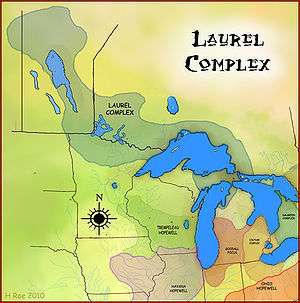Laurel Complex

The Laurel Complex was a Native American culture in southern Quebec, southern and northwestern Ontario and east-central Manitoba in Canada and northern Michigan, northwestern Wisconsin and northern Minnesota in the United States. They were the first pottery using people of Ontario north of the Trent-Severn Waterway. The complex is named after the former unincorporated community of Laurel, Minnesota.
Hopewell Interaction Sphere
The Hopewell Exchange system began in the Ohio and Illinois River Valleys about 300 BCE. The culture is referred to more as a system of interaction among a variety of societies than as a single society or culture. Hopewell trading networks were quite extensive, with obsidian from the Yellowstone area, copper from Lake Superior, and shells from the Gulf Coast.
The construction of ceremonial mounds was an important feature of the Laurel Complex, as it was for the Point Peninsula Complex and other Hopewell cultures. Sites were usually located at rapids or falls where sturgeon come to spawn and ceremonies may have coincided with this yearly event. The mounds and the artifacts contained within them indicate contact with the Adena and Hopewell of the Ohio River valley. It is unknown if the contact was direct or indirect.[1]
Kay-Nah-Chi-Wah-Nung
The first mound-builders in what is now the Kay-Nah-Chi-Wah-Nung National Historic Site of Canada,Laurel culture (c.2300 BP - 900 BP) who lived "in villages and built large round burial mounds along the edge of the river, as monuments to their dead."[2] There mounds remain visible today.[3] Kay-Nah-Chi-Wah-Nung is considered to be one of the "most significant centres of early habitation and ceremonial burial in Canada," is located on the north side Rainy River in Northwestern Ontario, Canada. It became part of a continent-wide trading network because of its strategic location at the centre of major North American waterways.[2]
See also
References
- ↑ "The Archaeology of Ontario-The Middle Woodland Period". Retrieved 2009-10-07.
- 1 2 "Kay-Nah-Chi-Wah-Nung", Parks Canada, Backgrounder, 26 September 2013, retrieved 13 January 2014
- ↑ "Kay-Nah-Chi-Wah-Nung National Historic Site of Canada: Statement of Significance", Parks Canada, Canada's Historic Places, 1998, retrieved 12 January 2014
External links
- The Footprints of Wasahkacahk: The Churchill River Diversion Project and Destrictuio of the Nelson House Cree Historical Landscape
- Initial Woodland Complexes in the Far North: The Laurel Culture, 50 B.C. to A.D. 1000

